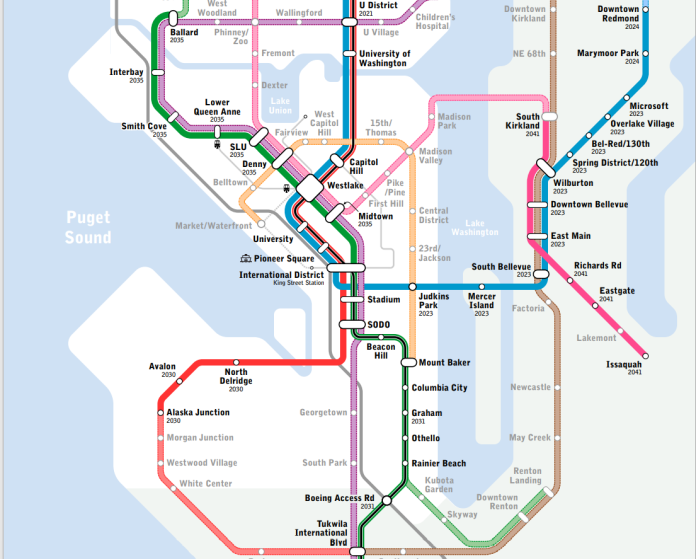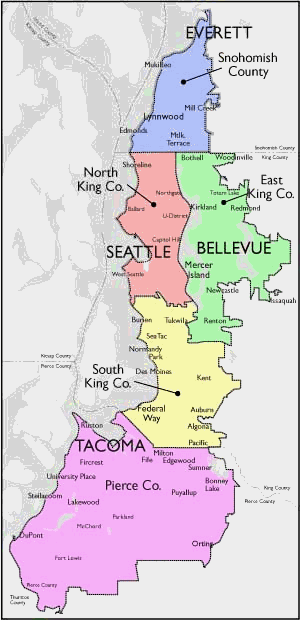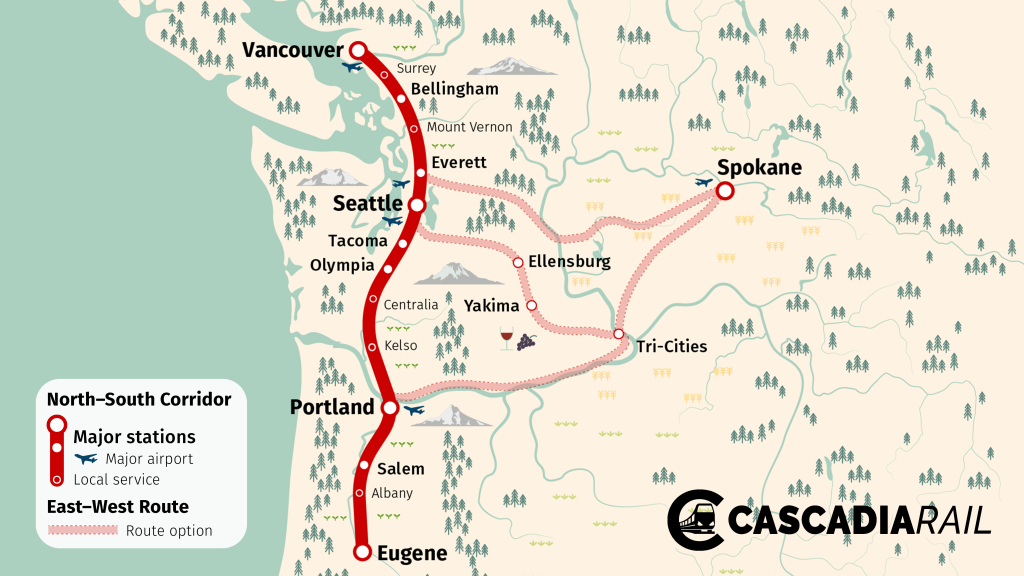Since 2012, Seattle Subway has been envisioning a world class rapid transit system for the Seattle region and advocating for that vision. Each year Subway has updated their vision map to reflect new realities and ideas. This year, their new map includes some interesting tweaks, such as a new line through Skyway and Renton, and extending the Aurora line to connect at Lynnwood City Center Station, which opens in 2024. Totem Lake also becomes a rail junction.
In all, Seattle Subway’s vision is for seven light rail lines creating a broad network stretching from Everett College in the north to Tacoma Mall in the south and from Edmonds east to Woodinville. It takes a light rail system, already planned to reach 116 miles after Sound Transit 3 (ST3) is built out, well past 200 miles, with at least 36 of those additional miles in Seattle. This allows Seattle to more than double the number of urban centers and urban villages connected, jumping from 13 of 30 in ST3 to 27 of 30 in the new map, Seattle Subway said. With King County projected to add 1.8 million residents by 2050, this kind of ambition might be warranted.
Seattle Subway also has a new executive director this year with Keith Kyle stepping aside and political director Jonathan Hopkins promoted to take over Kyle’s role. Hopkins is picking up right where his predecessor left off, laying out a bold vision for rapid transit expansion.
Rainier Valley to Renton Line
One focus of the new map is improving connections in South King County, where low-income and Black, Indigenous, and people of color (BIPOC) communities are concentrated in the region.
“One of the most amazingly equitable things we could do is build a south direct line express through South Park and Georgetown and then have that Rainier Valley line have 50% of the trains go through the Rainier Valley to Renton,” Hopkins said. “And we envision that as a sooner rather than later thing.”
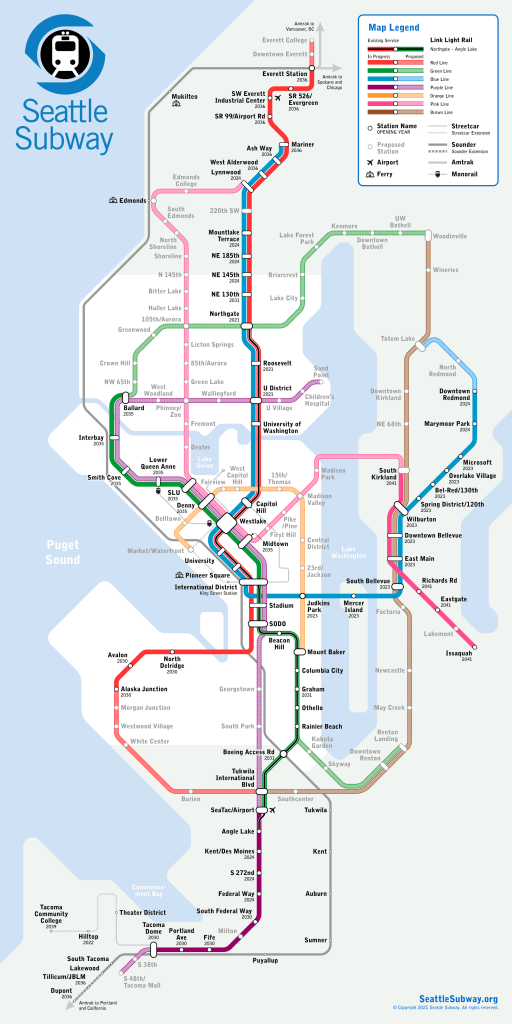
Those new light rail lines will have the effect of trimming multiple hours per week off the commutes of transit-dependent populations in South King County, Hopkins said. The express Purple Line through Georgetown would be much more direct than the existing Rainier Valley route, providing people who live in Tukwila and south of the city a much faster option to commute to Seattle.
Meanwhile, adding stations in Kubota Garden, Skyway, Downtown Renton, and Renton Landing to the Green Line branch would unite the Rainier Valley with rapid transit service, which would be unprecedented. With rising housing prices increasingly pushing BIPOC folks to the south, the Green Line could provide connectivity to communities displaced from their traditional homes and cultural centers in Seattle’s Central Area, Chinatown-International District, and the Rainier Valley.
Aurora Line extends to Lynnwood
One of Seattle Subway’s goals, Hopkins said, is to support urbanizing downtowns around the region. Edmonds’ efforts to pedestrianize its main street were not lost on him. “We want to reinforce communities that have dense, walkable downtowns and are making the right urban plans; Edmonds is fantastic for that,” Hopkins said.
The logic behind linking downtown Edmonds to the Aurora Line through Seattle and Shoreline and sending it onto Lynnwood also has much to do with strong transit connections to the Edmonds-Kingston ferry, which is the primary link to the northern half of the Kitsap Peninsula and the Olympic Peninsula beyond. Currently transit options to the Edmonds ferry aren’t great.
“If you’re going to connect… Edmonds is hard to reach, unless you have a car. We can make that intermodal connection to ferries, a good multimodal car-free one,” Hopkins said. “In our ideal world, if you make that light rail connection to the ferry system you can access it from Snohomish County as well as King County… It’s a state and regional asset, so we should make sure people can regionally access it.”
Terminating in Edmonds, as Subway’s 2019 map did (shown below), doesn’t provide Snohomish County the same level of connectivity to Edmonds and the ferry.
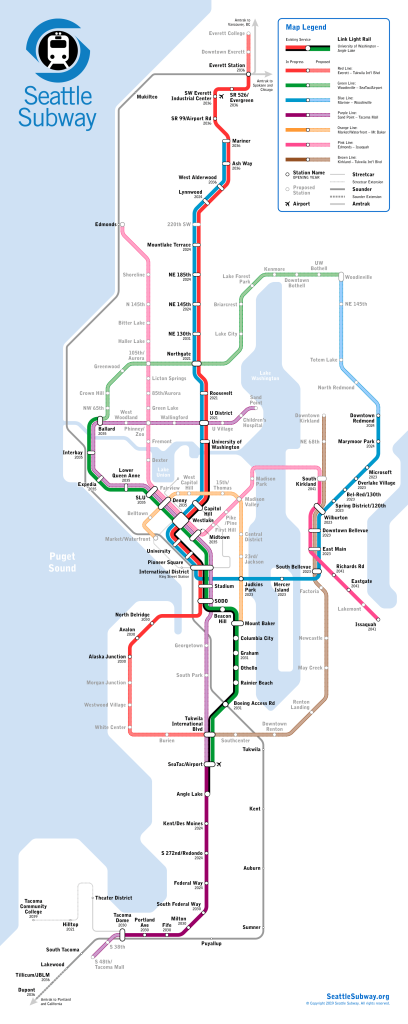
Totem Lake gets another line
The major change on the Eastside is extending Kirkland’s Brown line to Totem Lake and on to Woodinville. The Blue Line (East Link) then terminates in Totem Lake instead of going on Woodinville. That makes Totem Lake into quite the junction with direct connections to Redmond, Bellevue, and Woodinville.
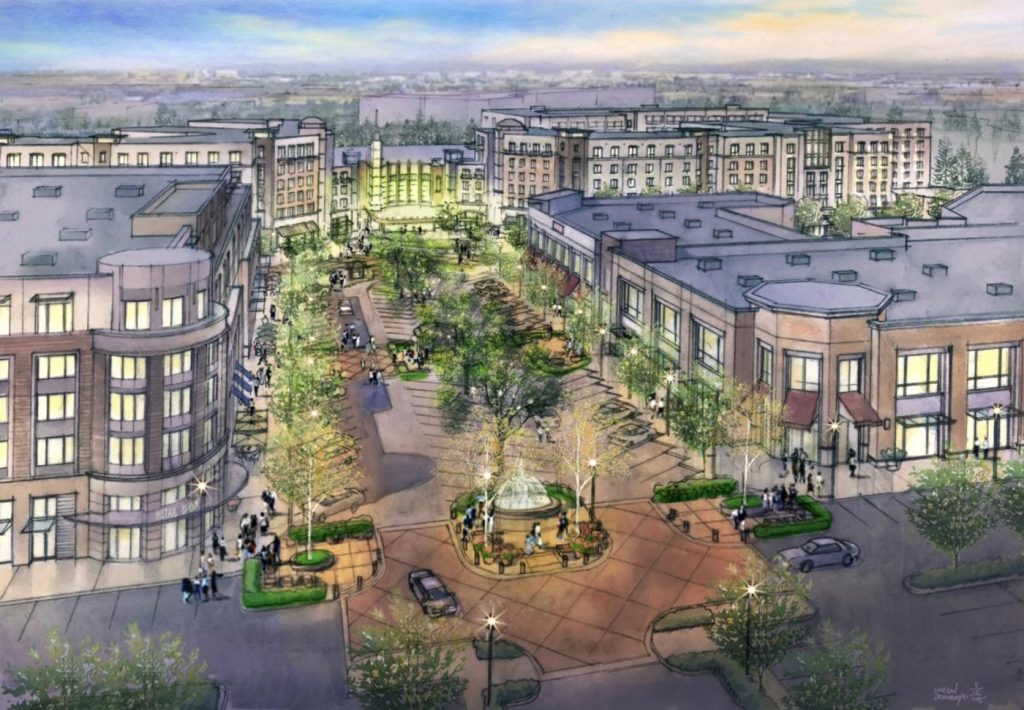
This might sound a bit much for those who think of Totem Lake as a sprawling mall with a culturally appropriative name, but Kirkland has designated the mall a regional urban growth center and has ambitious plans to redevelop it. So far, that has translated into a redevelopment building a more upscale mall with apartments over top. However, long-term the area could see a more profound urban transformation.
Pierce County ideas
Seattle Subway hasn’t changed anything in Pierce County, where the extension to Tacoma Mall (which similar to Totem Lake has been planned as an urban growth center) is the only addition they’ve tabbed. However, Hopkins, who grew up in Tacoma, is bullish about that city’s potential. He said additional bus rapid transit and streetcar lines make a ton of sense in Tacoma, but it’s less clear where light rail should go beyond Tacoma Mall. A streetcar up 6th Avenue would be a nice addition likely to attract heavy ridership, he said.
Because the Sound Transit Taxing District extends deep into Pierce County exurbia, ballot measures face more of an uphill battle in Pierce County, which was the only subarea to vote against ST3 with 55.76% voting no. Snohomish County, on the other hand, stays relatively tight to the denser core in Everett and points south and voted yes, albeit fairly narrowly with 51%. Pierce County has also grown slower than its northern neighbors over the past decade, although that could change as Tacoma booms and phases out exclusionary zoning policies.
High-speed connections and next steps
The core vision Seattle Subway has elevated has remained surprisingly similar over the organization’s decade of existence, even as more pieces are added. The maps near its founding in 2012 had already identified the Aurora Line, Ballard to University District, the Georgetown express line, West Seattle Link to White Center, and Ballard Link to Lake City as priorities. That vision pushed Sound Transit to go big with ST3 package — even as some groups wanted to play it safe with a smaller measure — and that boldness was rewarded with a decisive 54% victory.
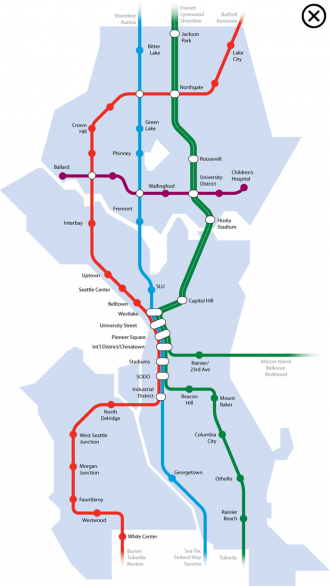
Seattle Subway has continued to tinker around the edges over the years, and it has added the ambitious Metro 8 Gold Line, too. However, many of the original lines remain high priority like the Aurora Line — not to mention ensuring delivery of Ballard Link and West Seattle Link is sped up and queued for extensions rather than talking about delays and cuts due to a tightening budget. That could entail a ST4 measure that ensures enough budget slack to keep ST3 on schedule while adding some new high priority additions, whether it be extending Ballard Link, West Seattle Link, and/or adding the Aurora Line and Renton Line.
Seattle Subway has also lobbied the state legislature to amend Seattle’s vestigial monorail taxing authority to fund light rail, and its bill — HB 1304 sponsored by Representative David Hackney — is likely to be back next session after stalling out this spring. If passed, it would give Seattle new options to fund light rail on its own, although Seattle Subway is still hoping for a regionwide or King County-wide package as well.
One new tie-in is high-speed rail, which another grassroots organization in Cascadia Rail has come together to advocate for. Hopkins believes high-speed rail could also be a winner based on polling commissioned by Puget Sound Regional Council. People throughout the region crave more mobility and transit options and it appears they’re ready to support it if it’s transformative enough. That shiny new high-speed rail right-of-way could then support faster metropolitan express rail transit options in the time slots between the interstate runs. Governor Jay Inslee has been advancing a governance plan partnering with British Colombia, Oregon, and potentially the private sector to get that Cascadia high-speed rail idea off the ground.
Seattle Subway’s vision maps might strike some as far-fetched and overly ambitious, but Puget Sound voters keep approving them. Polling suggests the appetite for bold transit upgrades and alternatives to driving remains.
Doug Trumm is publisher of The Urbanist. An Urbanist writer since 2015, he dreams of pedestrian streets, bus lanes, and a mass-timber building spree to end our housing crisis. He graduated from the Evans School of Public Policy and Governance at the University of Washington in 2019. He lives in Seattle's Fremont neighborhood and loves to explore the city by foot and by bike.

